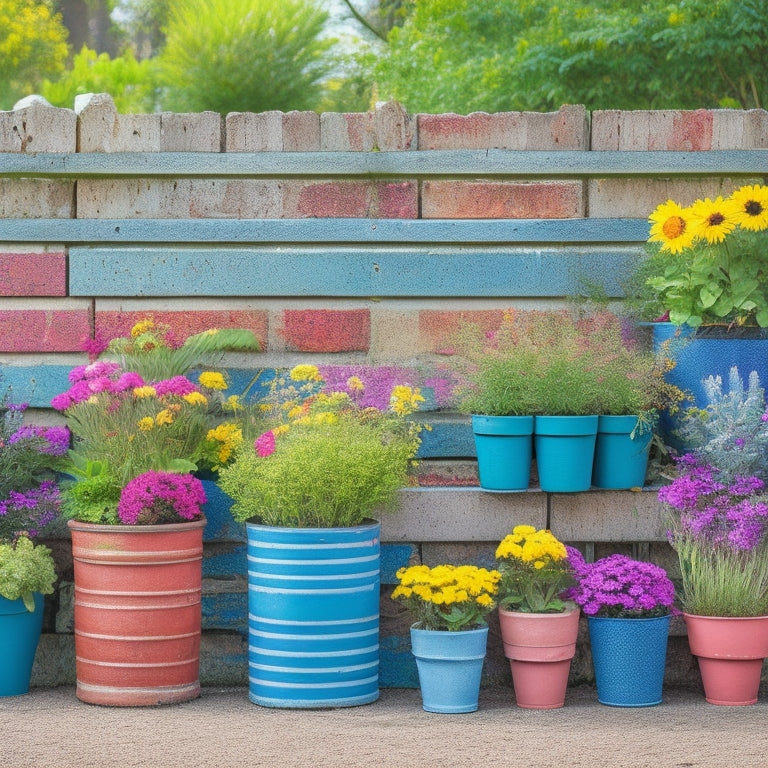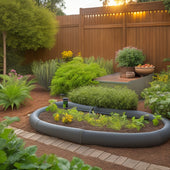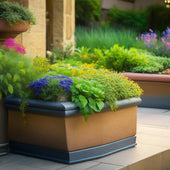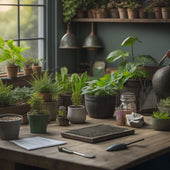
Cinder Block Planter Ideas on a Shoestring Budget
Share
You can elevate your outdoor space on a shoestring budget with creative cinder block planter ideas. Start with simple planters using stacked blocks, sand, and gravel, perfect for low-maintenance herbs. Get creative with upcycled and vertical gardens, maximizing small spaces and reducing waste. Repurpose old wood and pallets for budget-friendly planter boxes, or combine cinder blocks with bricks for a unique look. Add whimsy with playful arrangements, tiered designs, and colorful paint. With these ideas, you'll be well on your way to a stunning outdoor oasis. And, with a little more imagination, the possibilities will continue to unfold.
Key Takeaways
• Use recycled or free cinder blocks from construction sites to minimize costs for your planter project.
• Repurpose old wood, pallets, or crates as frames to add a unique touch to your planters without extra expense.
• Opt for low-maintenance plants like herbs, succulents, or vines that require minimal care and maintenance.
• Get creative with paint or stain to add color and personality to your planters without breaking the bank.
• Embrace imperfections and use irregularly shaped blocks or uneven arrangements to add a whimsical touch to your planters.
Simple Cinder Block Planters
Transform your outdoor space with a simple yet striking cinder block planter, which can be built in a few hours using basic materials and tools.
You'll need cinder blocks, sand, gravel, and a level to get started. Begin by arranging the blocks in a square or rectangle shape, depending on your desired design. Fill the gaps with sand and gravel to provide drainage, and you're ready to plant.
For a pop of color, add cinder block herbs like basil, rosemary, or thyme. These low-maintenance plants thrive in well-draining soil and can be easily accessed for cooking.
To add visual interest, consider building vertical cinder planters. Stack the blocks to create a sturdy base, then add a layer of soil and plants. Repeat this process until you reach the desired height.
You can also add a trellis or obelisk to support vining plants like ivy or clematis. With minimal effort and cost, you can create a beautiful and functional planter that enhances your outdoor space.
Upcycled Cinder Block Gardens
Take your cinder block planters to the next level by repurposing them into unique gardens that showcase your creativity and reduce waste.
You can create a stunning vertical garden by stacking cinder blocks on top of each other, leaving space between each block for plants to grow. This not only adds a decorative element but also maximizes space in small areas.
For a more whimsical look, you can arrange cinder blocks in a circular pattern, creating a mini garden oasis.
Another idea is to use cinder blocks as a retaining wall, creating a tiered garden that's both functional and visually appealing.
By embracing cinder block recycling, you'll reduce waste and create a one-of-a-kind garden that's sure to impress.
Plus, vertical gardening with cinder blocks allows you to grow a variety of plants in a small footprint, perfect for urban spaces or balconies.
Get creative and experiment with different designs – the possibilities are endless!
Budget-Friendly Planter Boxes
When creating budget-friendly planter boxes, you'll want to think outside the box - literally!
You can repurpose old wood to build the frame, stack cinder blocks for a unique design, or get creative with paint to give your planters a pop of color.
Build With Repurposed Wood
You can create a rustic, budget-friendly planter box by upcycling old pallets or wooden crates into a unique cinder block planter.
This repurposed wood planter isn't only eco-friendly but also adds a touch of rustic charm to your garden.
Simply disassemble the pallet or crate, and use the wooden planks to create the frame of your planter box.
You can then fill the box with a mix of soil and compost, and arrange your cinder blocks to create a visually appealing pattern.
Cinder Block Stacking
Stack cinder blocks in a staggered pattern to create a visually appealing, budget-friendly planter box that adds a modern touch to your garden. By arranging the blocks in a strategic way, you can create a unique and functional planter that's perfect for vertical gardening. Here are some ideas to get you started:
| Cinder Block Arrangement | Description | Space Required |
|---|---|---|
| Staggered Stack | Alternate blocks to create a staggered pattern | 3x3 feet |
| Pyramid Stack | Stack blocks in a pyramid shape for a dramatic effect | 4x4 feet |
| Crisscross Stack | Create a crisscross pattern by alternating block directions | 2x2 feet |
When building your planter box, make sure to leave enough space between each block for soil and roots to grow. You can also add a layer of landscape fabric or weed barrier to prevent weeds from growing up through the blocks. With a little creativity, you can create a beautiful and functional cinder block planter box that adds a touch of modern style to your garden.
Painted Planter Boxes
Transform your cinder block planters into vibrant, one-of-a-kind garden features by adding a fresh coat of paint, elevating your outdoor space without breaking the bank.
You'll be amazed at how a simple paint job can breathe new life into these humble planters. With a splash of color, you can create a statement piece that adds visual interest to your garden or patio.
Get creative with colorful patterns, like stripes or polka dots, to add a playful touch. You can also use stencils to create a more intricate design.
To really make your planter pop, choose a bold, contrasting color that complements your plant combinations. Imagine a bright yellow planter filled with lush greenery and vibrant flowers – it's a stunning combination that's sure to draw attention.
When choosing your paint, make sure to select a weather-resistant option that can withstand the elements.
With a little bit of creativity and some elbow grease, you can turn your cinder block planters into stunning works of art that add beauty and charm to your outdoor space.
DIY Cinder Block Patio
Create a stunning outdoor seating area by arranging cinder blocks in a pattern that defines your patio's boundaries and adds visual interest. You'll be surprised at how easily you can transform a bland space into a cozy retreat.
Start by laying down a layer of compacted gravel to guarantee proper cinder block drainage. This will prevent water from accumulating and make your patio more durable.
Next, arrange the cinder blocks in a pattern that resonates with your personal style. You can create a simple border, an intricate maze, or even a circular design. The key is to have fun and be creative!
Don't forget to take into account cinder block aesthetics when choosing your pattern. You can leave the blocks in their natural state or paint them to match your outdoor decor.
Add some outdoor furniture, plants, and string lights, and you'll have a patio that's perfect for relaxing and entertaining. With a little imagination, you can create a beautiful outdoor space that's both functional and budget-friendly.
Creative Block and Brick
You can elevate your outdoor decor by combining cinder blocks with bricks to form unique planters, walls, and borders that add texture and visual appeal to your space. This fusion of materials will bring a new level of sophistication to your outdoor area.
By stacking cinder blocks and bricks in a creative pattern, you can create a one-of-a-kind planter that showcases your greenery. The contrast between the rough, industrial look of cinder blocks and the classic, timeless appeal of bricks will add a touch of elegance to your outdoor decor.
To take your design to the next level, consider adding a pop of color with paint or stain. You can also experiment with different patterns and textures by arranging the blocks and bricks in a unique way.
Remember, the key to achieving great cinder creativity is to think outside the box and have fun with the process. By doing so, you'll be able to create a truly unique and visually stunning block aesthetic that reflects your personal style.
With a little imagination and creativity, you can turn a simple cinder block and brick combination into a breathtaking work of art.
Whimsical Cinder Block Designs
Stacking cinder blocks in playful, asymmetrical patterns adds a dash of whimsy to your outdoor space, allowing you to craft planters that are as visually intriguing as they're functional.
You can create unique arrangements by alternating block sizes, colors, or textures, resulting in a visually appealing display. For instance, try stacking blocks of varying heights to create a tiered planter or use blocks with different textures to add depth and interest.
To take your design to the next level, experiment with playful shapes, such as a circular or zigzag pattern. You can also incorporate other materials, like wooden planks or metal rods, to add an industrial touch.
Remember, the key to achieving a whimsical look is to think outside the box and embrace imperfection. Don't be afraid to get creative and try new things – it's all part of the fun!
With a little imagination, you can turn cinder blocks into a stunning focal point in your garden or backyard.
Frequently Asked Questions
Can I Use Old or Broken Cinder Blocks for Planters?
You're wondering if you can repurpose old or broken cinder blocks as planters. The answer is yes!
Using broken cinderblocks can add a unique touch to your outdoor space. Get creative and arrange them into a decorative pattern or stack them to create a tiered planter.
With a little imagination, you can turn discarded materials into stunning, one-of-a-kind planters that showcase your green thumb and flair for design.
How Do I Prevent Weeds From Growing in Cinder Block Planters?
Imagine a lush garden, but with weeds stealing the show. To prevent this, you'll want to focus on weed control.
Start by lining the inside of your planter with a weed barrier fabric or plastic sheeting. This will block weeds from growing up through the blocks.
For added protection, mulch around the plants to suppress weed growth.
Regular block maintenance, like cleaning and inspecting the blocks, will also help prevent weeds from taking over.
Are Cinder Block Planters Suitable for Indoor Use?
When considering indoor gardening, you'll want to know if cinder block planters are suitable for the job. The good news is, they can be!
However, you'll need to guarantee cinder block safety by sealing or painting the blocks to prevent moisture from seeping out.
Additionally, choose a well-draining potting mix and avoid overwatering to prevent water damage.
With proper care, cinder block planters can add a unique touch to your indoor space.
Can I Paint or Stain Cinder Blocks for a Decorative Look?
You're looking to add some flair to your cinder blocks! Yes, you can paint or stain them for a decorative look.
When painting, consider techniques like ombre, stripes, or stencils to create visual interest.
For staining, explore options like acid staining, concrete dye, or translucent stains to enhance the natural texture.
Whichever route you take, make certain to prime and seal the blocks properly to guarantee a durable, long-lasting finish.
Get creative and have fun with it!
Do Cinder Block Planters Require Drainage Holes?
When building planters, you'll want to guarantee they've proper drainage to prevent waterlogged soil.
You're wise to think about drainage solutions, as they're essential for planter maintenance. Without drainage holes, water can accumulate, causing roots to rot and plants to suffer.
Drill holes in the bottom of your cinder blocks or add a layer of small rocks for excess water to escape. This simple step will keep your plants thriving and your planters looking their best.
Conclusion
You've reached the final brick in the wall - and what a stunning structure you've built!
With these cinder block planter ideas, you've transformed a humble material into a masterpiece.
Your outdoor space is now a vibrant tapestry, woven with color, texture, and creativity.
Just as a painter adds finishing touches to a canvas, you've added the perfect flourish to your garden, proving that beauty can be built on a shoestring budget.
Related Posts
-

Irrigation Solutions for Raised Bed Planters Made Easy
You can optimize your raised bed planters' irrigation system by understanding the complex interplay between soil type...
-

Irrigation Solutions for Raised Bed Planters Made Easy
You can optimize your raised bed planters' irrigation system by understanding the complex interplay between soil type...
-

Irrigation Solutions for Raised Bed Planters Made Easy
You can optimize your raised bed planters' irrigation system by understanding the complex interplay between soil type...
-

Irrigation Solutions for Raised Bed Planters Made Easy
You can optimize your raised bed planters' irrigation system by understanding the complex interplay between soil type...
-

Irrigation Solutions for Raised Bed Planters Made Easy
You can optimize your raised bed planters' irrigation system by understanding the complex interplay between soil type...
-

Irrigation Solutions for Raised Bed Planters Made Easy
You can optimize your raised bed planters' irrigation system by understanding the complex interplay between soil type...
-

Irrigation Solutions for Raised Bed Planters Made Easy
You can optimize your raised bed planters' irrigation system by understanding the complex interplay between soil type...
-

Irrigation Solutions for Raised Bed Planters Made Easy
You can optimize your raised bed planters' irrigation system by understanding the complex interplay between soil type...
-

Irrigation Solutions for Raised Bed Planters Made Easy
You can optimize your raised bed planters' irrigation system by understanding the complex interplay between soil type...
-

Irrigation Solutions for Raised Bed Planters Made Easy
You can optimize your raised bed planters' irrigation system by understanding the complex interplay between soil type...
-

Irrigation Solutions for Raised Bed Planters Made Easy
You can optimize your raised bed planters' irrigation system by understanding the complex interplay between soil type...
-

Irrigation Solutions for Raised Bed Planters Made Easy
You can optimize your raised bed planters' irrigation system by understanding the complex interplay between soil type...
-

Irrigation Solutions for Raised Bed Planters Made Easy
You can optimize your raised bed planters' irrigation system by understanding the complex interplay between soil type...
-

Irrigation Solutions for Raised Bed Planters Made Easy
You can optimize your raised bed planters' irrigation system by understanding the complex interplay between soil type...
-

Irrigation Solutions for Raised Bed Planters Made Easy
You can optimize your raised bed planters' irrigation system by understanding the complex interplay between soil type...
-

Irrigation Solutions for Raised Bed Planters Made Easy
You can optimize your raised bed planters' irrigation system by understanding the complex interplay between soil type...
-

Irrigation Solutions for Raised Bed Planters Made Easy
You can optimize your raised bed planters' irrigation system by understanding the complex interplay between soil type...
-

Irrigation Solutions for Raised Bed Planters Made Easy
You can optimize your raised bed planters' irrigation system by understanding the complex interplay between soil type...
-

Irrigation Solutions for Raised Bed Planters Made Easy
You can optimize your raised bed planters' irrigation system by understanding the complex interplay between soil type...
-

Irrigation Solutions for Raised Bed Planters Made Easy
You can optimize your raised bed planters' irrigation system by understanding the complex interplay between soil type...
-

Irrigation Solutions for Raised Bed Planters Made Easy
You can optimize your raised bed planters' irrigation system by understanding the complex interplay between soil type...
-

Irrigation Solutions for Raised Bed Planters Made Easy
You can optimize your raised bed planters' irrigation system by understanding the complex interplay between soil type...
-

Irrigation Solutions for Raised Bed Planters Made Easy
You can optimize your raised bed planters' irrigation system by understanding the complex interplay between soil type...
-

Irrigation Solutions for Raised Bed Planters Made Easy
You can optimize your raised bed planters' irrigation system by understanding the complex interplay between soil type...
-

Irrigation Solutions for Raised Bed Planters Made Easy
You can optimize your raised bed planters' irrigation system by understanding the complex interplay between soil type...
-

Irrigation Solutions for Raised Bed Planters Made Easy
You can optimize your raised bed planters' irrigation system by understanding the complex interplay between soil type...
-

Irrigation Solutions for Raised Bed Planters Made Easy
You can optimize your raised bed planters' irrigation system by understanding the complex interplay between soil type...
-

Irrigation Solutions for Raised Bed Planters Made Easy
You can optimize your raised bed planters' irrigation system by understanding the complex interplay between soil type...
-

5 Essential Drainage Tips for Block Planters
When using block planters, you'll want to guarantee effective drainage to prevent waterlogging and root rot. Start by...
-

5 Essential Drainage Tips for Block Planters
When using block planters, you'll want to guarantee effective drainage to prevent waterlogging and root rot. Start by...
-

5 Essential Drainage Tips for Block Planters
When using block planters, you'll want to guarantee effective drainage to prevent waterlogging and root rot. Start by...
-

5 Essential Drainage Tips for Block Planters
When using block planters, you'll want to guarantee effective drainage to prevent waterlogging and root rot. Start by...
-

5 Essential Drainage Tips for Block Planters
When using block planters, you'll want to guarantee effective drainage to prevent waterlogging and root rot. Start by...
-

5 Essential Drainage Tips for Block Planters
When using block planters, you'll want to guarantee effective drainage to prevent waterlogging and root rot. Start by...
-

5 Essential Drainage Tips for Block Planters
When using block planters, you'll want to guarantee effective drainage to prevent waterlogging and root rot. Start by...
-

5 Essential Drainage Tips for Block Planters
When using block planters, you'll want to guarantee effective drainage to prevent waterlogging and root rot. Start by...
-

5 Essential Drainage Tips for Block Planters
When using block planters, you'll want to guarantee effective drainage to prevent waterlogging and root rot. Start by...
-

5 Essential Drainage Tips for Block Planters
When using block planters, you'll want to guarantee effective drainage to prevent waterlogging and root rot. Start by...
-

5 Essential Drainage Tips for Block Planters
When using block planters, you'll want to guarantee effective drainage to prevent waterlogging and root rot. Start by...
-

5 Essential Drainage Tips for Block Planters
When using block planters, you'll want to guarantee effective drainage to prevent waterlogging and root rot. Start by...
-

5 Essential Drainage Tips for Block Planters
When using block planters, you'll want to guarantee effective drainage to prevent waterlogging and root rot. Start by...
-

5 Essential Drainage Tips for Block Planters
When using block planters, you'll want to guarantee effective drainage to prevent waterlogging and root rot. Start by...
-

5 Essential Drainage Tips for Block Planters
When using block planters, you'll want to guarantee effective drainage to prevent waterlogging and root rot. Start by...
-

5 Essential Drainage Tips for Block Planters
When using block planters, you'll want to guarantee effective drainage to prevent waterlogging and root rot. Start by...
-

5 Essential Drainage Tips for Block Planters
When using block planters, you'll want to guarantee effective drainage to prevent waterlogging and root rot. Start by...
-

5 Essential Drainage Tips for Block Planters
When using block planters, you'll want to guarantee effective drainage to prevent waterlogging and root rot. Start by...
-

Why Invest in Specialized Planter Tools
You'll greatly boost your gardening success and yields by leveraging specialized planter tools that cater to the uniq...
-

Why Invest in Specialized Planter Tools
You'll greatly boost your gardening success and yields by leveraging specialized planter tools that cater to the uniq...
-

Why Invest in Specialized Planter Tools
You'll greatly boost your gardening success and yields by leveraging specialized planter tools that cater to the uniq...
-

Why Invest in Specialized Planter Tools
You'll greatly boost your gardening success and yields by leveraging specialized planter tools that cater to the uniq...
-

Why Invest in Specialized Planter Tools
You'll greatly boost your gardening success and yields by leveraging specialized planter tools that cater to the uniq...
-

Why Invest in Specialized Planter Tools
You'll greatly boost your gardening success and yields by leveraging specialized planter tools that cater to the uniq...
-

Why Invest in Specialized Planter Tools
You'll greatly boost your gardening success and yields by leveraging specialized planter tools that cater to the uniq...
-

Why Invest in Specialized Planter Tools
You'll greatly boost your gardening success and yields by leveraging specialized planter tools that cater to the uniq...
-

Why Invest in Specialized Planter Tools
You'll greatly boost your gardening success and yields by leveraging specialized planter tools that cater to the uniq...
-

Why Invest in Specialized Planter Tools
You'll greatly boost your gardening success and yields by leveraging specialized planter tools that cater to the uniq...
-

Why Invest in Specialized Planter Tools
You'll greatly boost your gardening success and yields by leveraging specialized planter tools that cater to the uniq...
-

Why Invest in Specialized Planter Tools
You'll greatly boost your gardening success and yields by leveraging specialized planter tools that cater to the uniq...
-

Why Invest in Specialized Planter Tools
You'll greatly boost your gardening success and yields by leveraging specialized planter tools that cater to the uniq...
-

Why Invest in Specialized Planter Tools
You'll greatly boost your gardening success and yields by leveraging specialized planter tools that cater to the uniq...
-

Why Invest in Specialized Planter Tools
You'll greatly boost your gardening success and yields by leveraging specialized planter tools that cater to the uniq...
-

Why Invest in Specialized Planter Tools
You'll greatly boost your gardening success and yields by leveraging specialized planter tools that cater to the uniq...
-

Why Invest in Specialized Planter Tools
You'll greatly boost your gardening success and yields by leveraging specialized planter tools that cater to the uniq...
-

Why Invest in Specialized Planter Tools
You'll greatly boost your gardening success and yields by leveraging specialized planter tools that cater to the uniq...
-

Why Invest in Specialized Planter Tools
You'll greatly boost your gardening success and yields by leveraging specialized planter tools that cater to the uniq...
-

Why Invest in Specialized Planter Tools
You'll greatly boost your gardening success and yields by leveraging specialized planter tools that cater to the uniq...
-

Why Invest in Specialized Planter Tools
You'll greatly boost your gardening success and yields by leveraging specialized planter tools that cater to the uniq...
-

Why Invest in Specialized Planter Tools
You'll greatly boost your gardening success and yields by leveraging specialized planter tools that cater to the uniq...
-

Why Invest in Specialized Planter Tools
You'll greatly boost your gardening success and yields by leveraging specialized planter tools that cater to the uniq...
-

Why Invest in Specialized Planter Tools
You'll greatly boost your gardening success and yields by leveraging specialized planter tools that cater to the uniq...
-

Why Invest in Specialized Planter Tools
You'll greatly boost your gardening success and yields by leveraging specialized planter tools that cater to the uniq...


